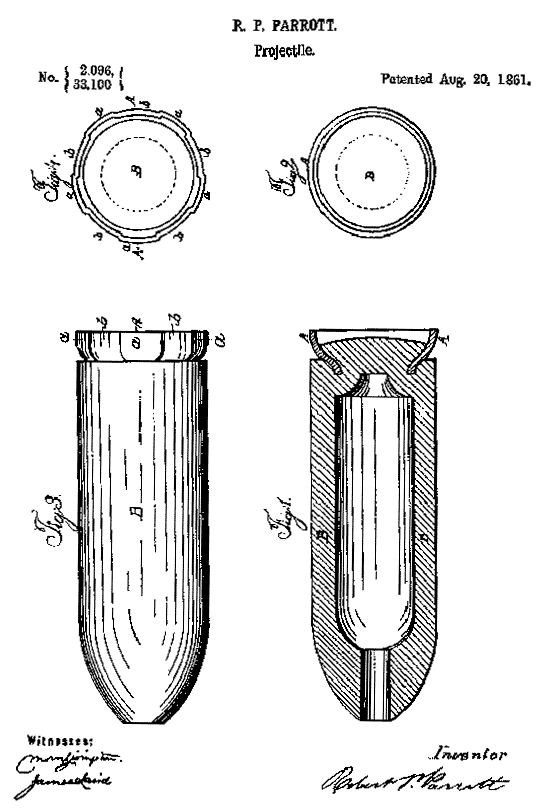 UNITED STATES PATENT OFFICE.
UNITED STATES PATENT OFFICE.___________________________________
ROBERT P. PARROTT, OF COLD SPRING, NEW YORK.
___________________________________
PROJECTILE FOR RIFLED ORDNANCE.
___________________________________
Specification of Letters Patent No. 33,100, dated August 20, 1861.
___________________________________
To all whom it may concern:
Be it known that I, ROBERT P. PARROTT, of Cold Spring, in the county of Putnam and State of New York, have invented a new and useful Improvement in Projectiles for Rifled Ordnance; and I do hereby declare that the following is a full, clear, and exact description of the same, reference being had to the accompanying drawings, forming part of this specification.
This invention consists in an improvement upon the elongated projectile for which Letters Patent of the United States were issued on the 28th day of October, 1856, to John B. Read. That projectile had attached to its rear a wrought-iron cup, the edges of which were to be driven into the rifle-grooves of the gun by the action of the explosion of the charge of powder; but it has been found by experiment that when the edges of the said cups were made thin enough to insure their entrance into the grooves of the gun in such a manner as to prevent windage and obtain a rotary motion of the projectile the cups became so weak as to be liable, to break away from the body of the projectile, and were, besides, liable to injury in handling. In order to prevent this, I make the said cup, more especially at its edges, of greater thickness, and to insure its proper entrance into the grooves I swage or otherwise form the said cup before the insertion of the projectile in the gun in such manner that in loading it will enter into the grooves in such manner that it will not interfere with the free loading of the gun, but that it will be driven completely into the grooves and caused to fit the grooves and lands by the force of the explosion of the charge of powder without any danger of its being broken.
To enable others to fully understand my improvement, I will proceed to describe it with reference to the drawings.
Figure 1 is a central longitudinal section of the projectile in its condition before the swaging or forming of the cup to enter the grooves. Fig. 2 is a rear view of the same. Fig. 3 is a longitudinal outside view of the projectile in its finished condition, and Fig. 4 is a rear view of the same.
Similar letters of reference indicate corresponding parts in the several figures.
The cup A when first made and before its attachment to the projectile is of perfect circular form, as shown in Fig. 2, and of no greater diameter than that which the body B of the projectile is to have when finished, as shown in Figs. 1 and 2. It is attached to the body B by placing it in the mold in which the body is to be cast in such manner that after the casting it will be embedded in the metal of the body. After the body has been turned or otherwise made true I place the projectile, with the cup upward or outward, in a cylinder of iron or steel of just sufficient caliber and depth to receive it, and consequently of a caliber a little less than that of the gun for which the projectile is intended, such cylinder being grooved similarly to the gun, except that its grooves are about one-twentieth of an inch less in width and depth than those of the gun. When the projectile has been placed in this cylinder with the edge of the cup even with the mouth thereof, the cup is driven outward into the several grooves thereof in such a manner as to fit them by means of a hammer and a suitable tool, and when the projectile is removed from the said cylinder the projections a a, (see Figs. 3 and 4,) formed on the cup by driving the wrought-iron into the grooves of the solid cylinder, will pass so easily through the grooves of the gun, and the intervening portions b b of the exterior of the cup will pass so easily along the lands thereof, that no obstruction occurs in the loading of the gun.
When the gun is fired, the force of the explosion of the powder causes the expansion of the cup in a lateral direction in such a manner that its projections a a will fit closely into the grooves of the gun, and the intervening portions b b will fit snugly to the lands, and hence windage will be effectually prevented and a rotary motion of the projectile insured.
Instead of forming the projections a a on the cup by means described, they may be formed by pressure between suitable [illegible] before the casting of the body of the projectile.
I do not confine myself to the use of any particular process of forming the projections on the wrought-iron cup A; but
What I claim as my invention, and desire to secure by Letters Patent, is –
The formation of such wrought-iron cup before the insertion of the projectile into the gun with projections a a to enter into the rifle-grooves, substantially as herein described.
ROBERT P. PARROTT.
Witnesses:
JAMES LAIRD,
M. M. LIVINGSTON.